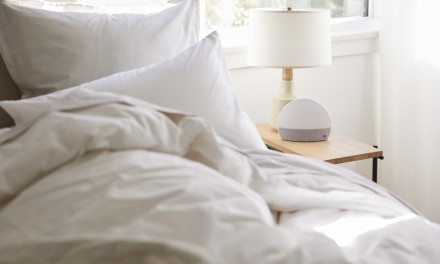External noises disrupt some people's sleep, while others have trouble dozing off in absolute silence. In either case, pink noise (a cousin of white noise) might help.
Below, you’ll find answers to questions like:
What is pink noise good for?
What is pink noise for sleep?
What is considered pink noise?
Keep reading to learn what this sound is, what it sounds like, its potential benefits and how it differs from other types of sleep-inducing frequencies.
What Is Pink Noise?
Pink noise is an assortment of sounds containing all frequencies humans can hear. Lower frequencies are slightly louder, and higher frequencies are less intense, but all octaves have the same noise energy. Sometimes called fractal noise, is often used to tune loudspeakers and instruments.
What Does Pink Noise Sound Like?
Pink noise often sounds like noises you'd hear in nature. Many describe it as a waterfall-like noise, but it can also sound like wind, rain, a flowing river, the ocean or birdsongs. Pink noise is sometimes reminiscent of urban soundscapes, like cars in traffic (without the honking) or train wheels rolling on tracks.
For many people, the mix of high and low frequencies at a balanced intensity is pleasant and soothing. Pink noise also has the ability to block out unpleasant noises without sounding shrill or harsh. This is why lots of folks find it more relaxing than white noise, which is often higher-pitched.
What Does Pink Noise Do for Sleep?
Like white noise, pink noise helps block out unwanted background noises and replaces them with more soothing sounds. As a result, it can help people (including everyone from adults to kids to infants) fall asleep faster and may help particularly light sleepers get the rest they need.
One small study found that listening to pink noise while sleeping slowed down the participants' brain activity, implying that it could help you get more deep sleep. Another study suggested that pink noise helped participants achieve REM (rapid eye movement), which is associated with dreaming, memory and healthy brain development.
Good sleep quality is crucial for your overall health — but why, exactly? Dive deeper with our blog, Sleep: An Instinctual Necessity.
How Pink Noise Works
Pink noise is one of a few noise colors (including white and brown, among others — more on this below). Each hue describes the frequencies present in the noise. Pink noise is termed pink because the visible light of its unique power spectrum (more audible low frequencies and less audible high frequencies) is pink in appearance.
What Is Pink Noise?
Pink noise is an assortment of sounds containing all frequencies humans can hear. Lower frequencies are slightly louder, and higher frequencies are less intense, but all octaves have the same noise energy. Sometimes called fractal noise, is often used to tune loudspeakers and instruments.
What Does Pink Noise Sound Like?
Pink noise often sounds like noises you'd hear in nature. Many describe it as a waterfall-like noise, but it can also sound like wind, rain, a flowing river, the ocean or birdsongs. Pink noise is sometimes reminiscent of urban soundscapes, like cars in traffic (without the honking) or train wheels rolling on tracks.
For many people, the mix of high and low frequencies at a balanced intensity is pleasant and soothing. Pink noise also has the ability to block out unpleasant noises without sounding shrill or harsh. This is why lots of folks find it more relaxing than white noise, which is often higher-pitched.
What Does Pink Noise Do for Sleep?
Like white noise, pink noise helps block out unwanted background noises and replaces them with more soothing sounds. As a result, it can help people (including everyone from adults to kids to infants) fall asleep faster and may help particularly light sleepers get the rest they need.
One small study found that listening to pink noise while sleeping slowed down the participants' brain activity, implying that it could help you get more deep sleep. Another study suggested that pink noise helped participants achieve REM (rapid eye movement), which is associated with dreaming, memory and healthy brain development.
Good sleep quality is crucial for your overall health — but why, exactly? Dive deeper with our blog, Sleep: An Instinctual Necessity.
How Pink Noise Works
Pink noise is one of a few noise colors (including white and brown, among others — more on this below). Each hue describes the frequencies present in the noise. Pink noise is termed pink because the visible light of its unique power spectrum (more audible low frequencies and less audible high frequencies) is pink in appearance.
What Is Pink Noise vs. White Noise vs. Brown Noise?
What Is Pink Noise vs. White Noise vs. Brown Noise?
So, how are pink and white noise different? And what is the difference between pink noise and brown noise? To the untrained ear, these sounds might seem similar in that they're non-musical background noises, but each is actually distinct.
Pink noise includes all sounds humans can hear, with amplified lower frequencies and reduced high frequencies.
White noise also includes all sounds the human ear can hear. While it's effective at masking external sounds, some people find it grating. That’s because without its higher frequencies reduced, it can sound annoyingly high-pitched.
Brown noise (sometimes called red noise) includes all audible sounds as well, but the lowest bass frequencies are the strongest with this type of noise. With a deep, steady rumbling sound even lower than pink noise, people who suffer from tinnitus and others sensitive to higher pitches may prefer this auditory color.
How to Get Pink Noise
You can get pink noise in many mobile apps, including some of the most popular music apps, like Apple Music and Spotify. Another option is to get a sound machine.
But bear in mind most noise machines are simply called "white noise machines," even if they have pink, brown and other sound color options. So, how do you know what's pink noise? Listen for relatively low, soothing sounds, like a waterfall, rainfall or waves crashing.
How to Get White Noise
White noise is easiest to find, whether you use a mobile app or buy a white noise machine. Many people refer to all non-musical sleep sounds as "white noise," even when they're technically pink, brown or another color. But some examples of distinctly white noise (with equally high and low tones) are television static and a running vacuum.
How to Get Brown Noise
In addition to mobile apps and white noise machines, you can download brown noise sound therapy tracks from the American Tinnitus Association.
How to Use Pink Noise Safely and Effectively
Though auditory colors help many people fall asleep and potentially sleep deeper, certain sounds and pitches could make it harder to get high-quality shut-eye.
For some, white noise is too high-pitched to be tranquilizing. A better, more soothing option might be pink noise because the lower tones will be more noticeable than the higher ones. Try a few sleep sounds until you find one that makes you feel relaxed enough to fall asleep.
No matter what color you choose, you'll want to think about the volume. Listening to anything too loud could damage your eardrums or lead to hearing loss, especially when using headphones.
And remember, sound isn't the only thing that matters when falling asleep. It's best to go to bed and wake up at a similar time each day. Also, try to keep your bedroom as dark as possible, and avoid using your phone before bed to minimize stimulating lights.
Speaking of light, check out our article on Daylight Savings Ending to see if the bi-annual time change could be over for good soon.
How to Use Pink Noise Safely and Effectively
Though auditory colors help many people fall asleep and potentially sleep deeper, certain sounds and pitches could make it harder to get high-quality shut-eye.
For some, white noise is too high-pitched to be tranquilizing. A better, more soothing option might be pink noise because the lower tones will be more noticeable than the higher ones. Try a few sleep sounds until you find one that makes you feel relaxed enough to fall asleep.
No matter what color you choose, you'll want to think about the volume. Listening to anything too loud could damage your eardrums or lead to hearing loss, especially when using headphones.
And remember, sound isn't the only thing that matters when falling asleep. It's best to go to bed and wake up at a similar time each day. Also, try to keep your bedroom as dark as possible, and avoid using your phone before bed to minimize stimulating lights.
Speaking of light, check out our article on Daylight Savings Ending to see if the bi-annual time change could be over for good soon.
Frequently Asked Questions About Pink Noise
Find answers to frequently asked questions about pink noise below.
Is it OK to listen to pink noise all night?
It's generally considered safe to sleep with pink noise on all night. While it might help you fall asleep (and help you get more stable sleep) by blocking out external sounds, you'll want to be careful about not keeping the volume too high.
What is the best color noise for sleep?
Some consider pink noise the best color for sleep, as it minimizes the higher (potentially irksome) pitches. However, many people like white noise for its more equal distribution of tones, and those with tinnitus might want to go even lower than pink with brown noise.
What are examples of pink noise?
Examples of pink noise include a waterfall, a flowing river, a babbling brook, ocean waves crashing, wind blowing and rainfall. Beyond nature sounds, pink noise can include urban noises like traffic or a rolling train. You can check out this example of pink noise from Sleep Foundation.
What frequency is pink noise?
Sound frequencies are measured in hertz (Hz). Pink noise encompasses all frequencies that humans can hear, ranging from 20 to 20,000 hertz. But the lowest frequencies (500 hertz and below) are the most audible in pink noise.
Frequently Asked Questions About Pink Noise
Find answers to frequently asked questions about pink noise below.
Is it OK to listen to pink noise all night?
It's generally considered safe to sleep with pink noise on all night. While it might help you fall asleep (and help you get more stable sleep) by blocking out external sounds, you'll want to be careful about not keeping the volume too high.
What is the best color noise for sleep?
Some consider pink noise the best color for sleep, as it minimizes the higher (potentially irksome) pitches. However, many people like white noise for its more equal distribution of tones, and those with tinnitus might want to go even lower than pink with brown noise.
What are examples of pink noise?
Examples of pink noise include a waterfall, a flowing river, a babbling brook, ocean waves crashing, wind blowing and rainfall. Beyond nature sounds, pink noise can include urban noises like traffic or a rolling train. You can check out this example of pink noise from Sleep Foundation.
What frequency is pink noise?
Sound frequencies are measured in hertz (Hz). Pink noise encompasses all frequencies that humans can hear, ranging from 20 to 20,000 hertz. But the lowest frequencies (500 hertz and below) are the most audible in pink noise.
High Quality Sleep Essentials From Parachute
High Quality Sleep Essentials From Parachute
Finding a sound color that works for you is only one component in achieving high-quality sleep. To get your best-ever shut-eye, consider upgrading your sleeping quarters. Parachute has all the bedroom essentials you need, including a universally comfortable mattress, pillows for every sleeping style and sustainably sourced bedding.
If you need help choosing colors or materials for your space, a seasoned interior stylist at Parachute is here to assist. Schedule your complimentary virtual design consultation today.
Read Next:
What (and Who) Is The Parachute Design Services Team?
Guide to Design and Decor Ideas for Your Home
External Sources:
Overath T, Zhang Y, Sanes DH, Poeppel D. Sensitivity to temporal modulation rate and spectral bandwidth in the human auditory system: fMRI evidence. J Neurophysiol. 2012. doi: 10.1152/jn.00308.2011.
Boynton E. What is pink noise?. Right As Rain by UW Medicine. 2020. Web.
Messineo L, et al. Broadband Sound Administration Improves Sleep Onset Latency in Healthy Subjects in a Model of Transient Insomnia. Frontiers in Neurology. 2017. doi.org/10.3389/fneur.2017.00718
Papalambros NA, et al. Acoustic Enhancement of Sleep Slow Oscillations and Concomitant Memory Improvement in Older Adults. Frontiers in Human Neuroscience. 2017. doi.org/10.3389/fnhum.2017.00109
Ong JL, et al. Effects of phase-locked acoustic stimulation during a nap on EEG spectra and declarative memory consolidation. Sleep Medicine. 2016. doi.org/10.1016/j.sleep.2015.10.016
Downey A. Think Complexity. O'Reilly Media. p. 79. ISBN 978-1-4493-1463-7. Visible light with this power spectrum looks pink, hence the name. 2012.
Barozzi S, et al. Effects of tinnitus retraining therapy with different colors of sound. The International Tinnitus Journal. 2017. doi: 10.5935/0946-5448.20170026.
National Institute on Deafness and Other Communication Disorders. Noise-Induced Hearing Loss. National Institute of Health (NIH). 2022. Web.
Cleveland Clinic. Can Pink Noise Help You Sleep?. Health Essentials. 2022. Web.







